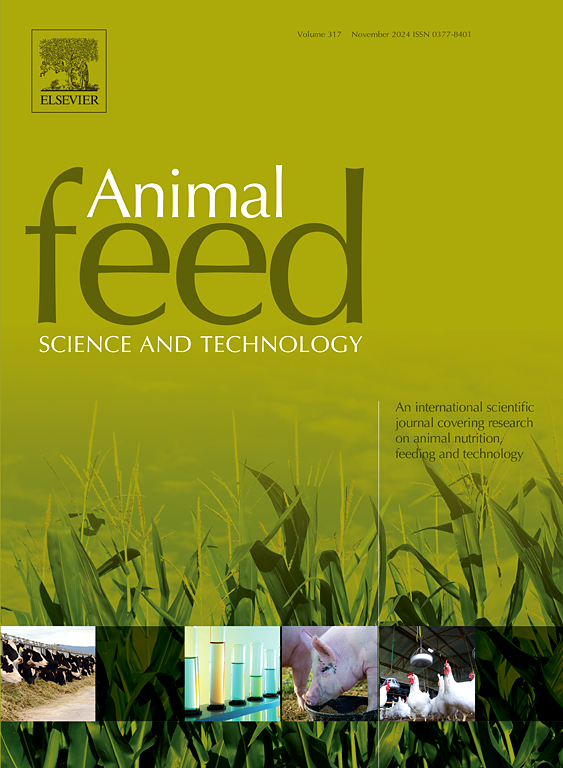尼罗罗非鱼(Oreochromis niloticus)在生物絮凝物系统中饲喂发酵甜菜蔗渣饲料的生长和生理反应
IF 2.7
2区 农林科学
Q1 AGRICULTURE, DAIRY & ANIMAL SCIENCE
引用次数: 0
摘要
甜菜渣(SB)是一种常见的农用工业废料,可用于动物饲料。然而,由于其粗纤维含量高,鱼类很难消化。发酵过程可以提高 SB 副产品的营养价值。该研究利用鼠李糖乳杆菌和酵母(酿酒酵母)发酵 SB 废弃物,将其用作尼罗罗非鱼幼苗的豆粕替代品。这导致蛋白质、脂质、灰分和无氮提取物含量增加,而纤维含量减少。四种实验性等氮(粗蛋白:249.2 g kg-1)等热(毛能:18.25 MJ kg-1)日粮的配方如下:对照组日粮含 0 % LYFSB(鼠李糖球菌和酵母菌),对照组日粮含 0 % LYFSB(酵母菌),对照组日粮含 0 % LYFSB(鼠李糖球菌和酵母菌)。LYFSB10 %)、20 %(LYFSB20 %)和 30 %(LYFSB30 %)的对照日粮。将 180 尾尼罗罗非鱼幼苗(平均初始体重为 5.19 ± 0.02 克)随机放入 12 个圆形塑料水槽(容量为 60 升)中,每个水槽的放养密度为 15 尾鱼。随着罗非鱼日粮中 LYFSB 替代量的增加,亚硝酸盐和氨氮水平下降,而硝酸盐水平则呈现相反的趋势。浮游植物群落包括生物絮团系统中的 9 个物种和罗非鱼肠道内容物中的 4 个物种,其中叶绿藻是最常见的种类,在鱼饲料中数量最多(7805.67 个/毫升)。研究显示,LYFSB 对浮游动物群落有显著影响,生物絮凝水中以原生动物为主,罗非鱼肠道中以轮虫为主。LYFSB10 % 和 LYFSB20 % 的细菌数量最高。用 LYFSB10 % 和 LYFSB20 % 日粮喂养的鱼的特定生长率(2.51 % 天-1)和增重(24.92 克鱼-1)值最高。这些日粮还显示出胰蛋白酶、脂肪酶和淀粉酶活性水平的提高。在鱼类日粮中添加 LYFSB 作为 FM 的替代品,可改善鱼类的肠道和肝脏健康。添加 LYFSB10 % 和 LYFSB20 % 的日粮中球蛋白、总蛋白、白蛋白和 IgM 含量最高,两者之间无显著差异。喂食 LYFSB10 % 的鱼胆固醇和甘油三酯水平较低。喂食 LYFSB10 % 和 LYFSB20 % 的鱼的超氧化物歧化酶(SOD)和过氧化氢酶(CAT)活性最高,而喂食 LYFSB30 % 的鱼的丙二醛(MDA)活性最低。研究表明,生物絮团系统改善了水质,提高了投喂 LYFSB10 % 和 LYFSB20 % 的罗非鱼的效率。本文章由计算机程序翻译,如有差异,请以英文原文为准。
Growth and physiological responses of Nile tilapia, Oreochromis niloticus fed dietary fermented sugar beet bagasse and reared in biofloc system
Sugar beet bagasse (SB) is a common agro-industrial waste used in animal feeds. However, its high crude fiber content makes it difficult for fish to digest. Fermentation processes can improve the nutritional value of SB by-products. The study uses Lactobacillus rhamnosus and yeast (Saccharomyces cerevisiae) to ferment SB waste for use as a soybean meal substitute in Nile tilapia fingerlings. This led to an increase in protein, lipid, ash, and nitrogen-free extracts, while the fiber content decreased. Four experimental isonitrogenous (crude protein: 249.2 g kg−1) and isocaloric (gross energy:18.25 MJ kg−1) diets were formulated as follows: a control diet with 0 % LYFSB (L. rhamnosus and yeast fermented SB), and three other diets with LYFSB replacing soybean meal (SBM) at levels of 10 % (LYFSB10 %), 20 % (LYFSB20 %), and 30 % (LYFSB30 %) based on protein content, over a 70-day period. 180 fingerlings of Nile tilapia (average initial weight of 5.19 ± 0.02 g) were placed at random in twelve circular plastic tanks (60 L capacity) with a stocking density of fifteen fish each. Nitrite and ammonia levels decreased as the replacement levels of LYFSB in tilapia diets increased, while nitrate levels showed the opposite trend. The phytoplankton community includes nine species in the biofloc system and four in tilapia gut content, with Chlorophyceae being the most common class, having the highest number in fish-fed diets (7805.67 organism/ml). The study revealed that LYFSB significantly influenced the zooplankton community, with protozoa dominating in biofloc water and rotifer in tilapia gut. LYFSB10 % and LYFSB20 % had the highest bacteria counts. Fish fed with LYFSB10 % and LYFSB20 % diets showed the highest values for specific growth rate (2.51 % day−1) and weight gain (24.92 g fish−1). These diets also exhibited increased activity levels of trypsin, lipase, and amylase enzymes. Increasing the inclusion of LYFSB in fish diets as a replacement for FM improved the intestinal and liver health of fish. The diets with LYFSB10 % and LYFSB20 % showed the highest levels of globulin, total protein, albumin, and IgM, with no significant differences between them. Fish fed LYFSB10 % had lower cholesterol and triglyceride levels. Superoxide dismutase (SOD) and catalase (CAT) activities were highest in fish fed LYFSB10 % and LYFSB20 %, while malondialdehyde (MDA) activity was lowest in the LYFSB30 % diet. The study showed that the biofloc system enhanced water quality and increased the efficiency of tilapia fed LYFSB10 % and LYFSB20 %.
求助全文
通过发布文献求助,成功后即可免费获取论文全文。
去求助
来源期刊

Animal Feed Science and Technology
农林科学-奶制品与动物科学
CiteScore
6.00
自引率
6.20%
发文量
266
审稿时长
3 months
期刊介绍:
Animal Feed Science and Technology is a unique journal publishing scientific papers of international interest focusing on animal feeds and their feeding.
Papers describing research on feed for ruminants and non-ruminants, including poultry, horses, companion animals and aquatic animals, are welcome.
The journal covers the following areas:
Nutritive value of feeds (e.g., assessment, improvement)
Methods of conserving and processing feeds that affect their nutritional value
Agronomic and climatic factors influencing the nutritive value of feeds
Utilization of feeds and the improvement of such
Metabolic, production, reproduction and health responses, as well as potential environmental impacts, of diet inputs and feed technologies (e.g., feeds, feed additives, feed components, mycotoxins)
Mathematical models relating directly to animal-feed interactions
Analytical and experimental methods for feed evaluation
Environmental impacts of feed technologies in animal production.
 求助内容:
求助内容: 应助结果提醒方式:
应助结果提醒方式:


